Evaluation of Emergency Response Capacity of Urban Pluvial Flooding Public Service Based on Scenario Simulation
Abstract
1. Introduction
2. Study Area and Data Sources
2.1. Study Area
2.2. Data Sources
3. Method
3.1. Precipitation Data
3.2. SCS-CN Model

3.3. Evaluation of Flood Emergency Response Capacity
3.3.1. Selection and Processing of Indicator Data
3.3.2. Combination Weighting Method
4. Results and Discussion
4.1. Flood Inundation Analysis
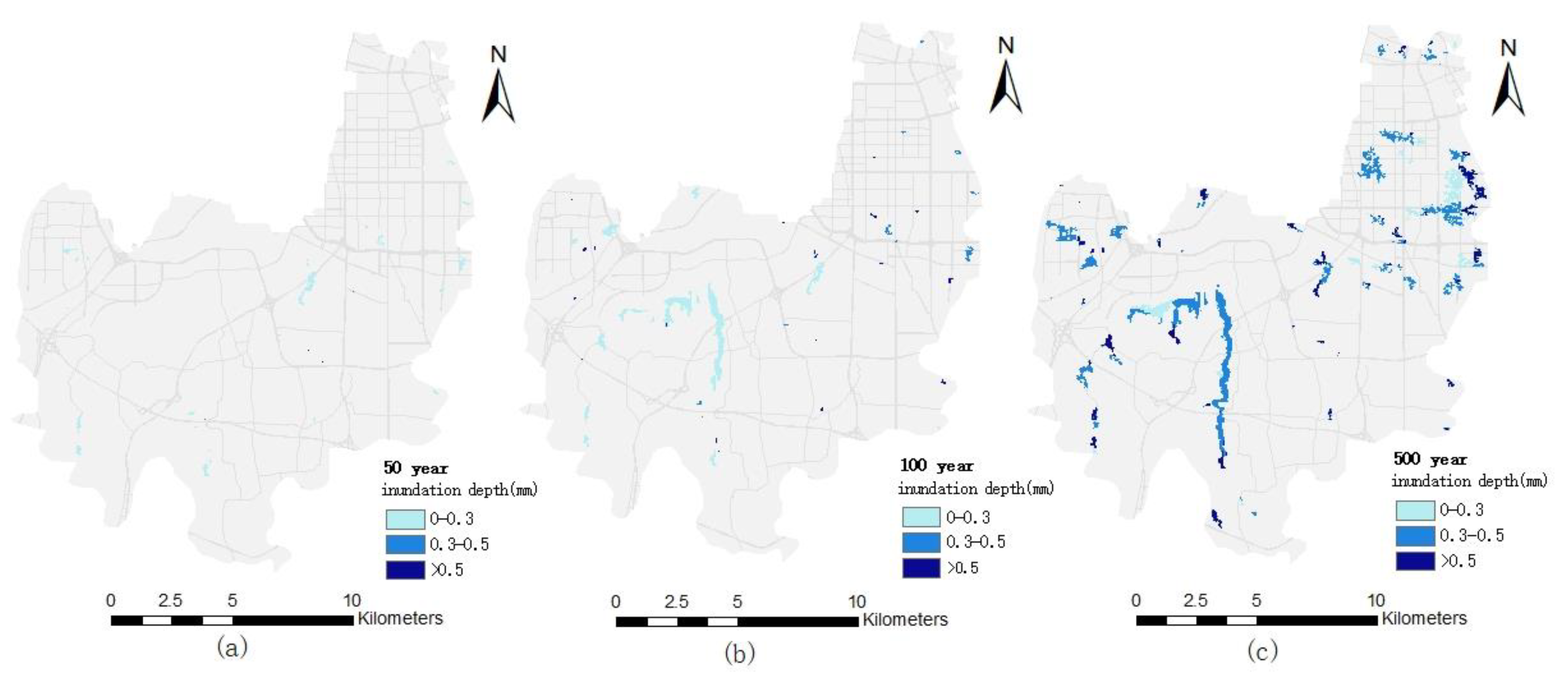
4.2. Evaluation of Emergency Response Capability
4.2.1. Emergency Response Capacity of Medical Institutions
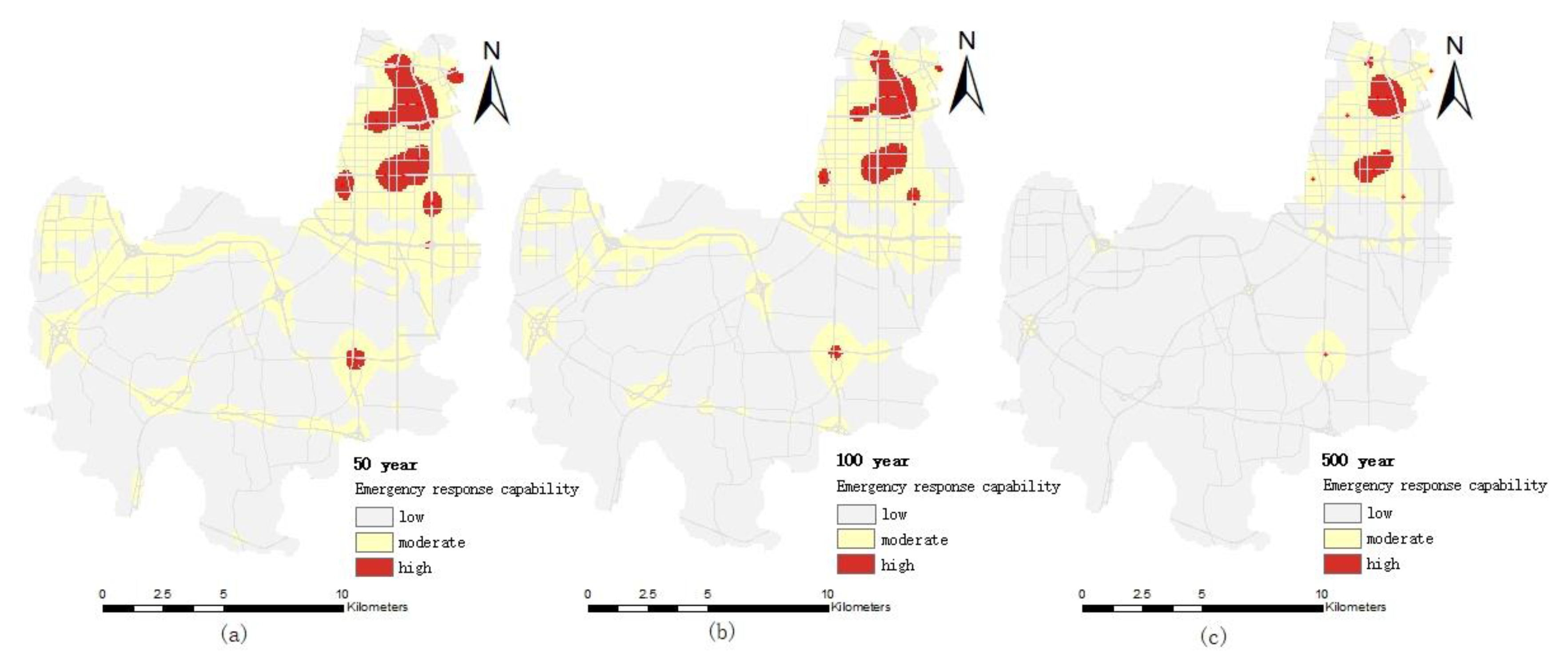
4.2.2. Emergency Response Capability of Firefighting Institutions
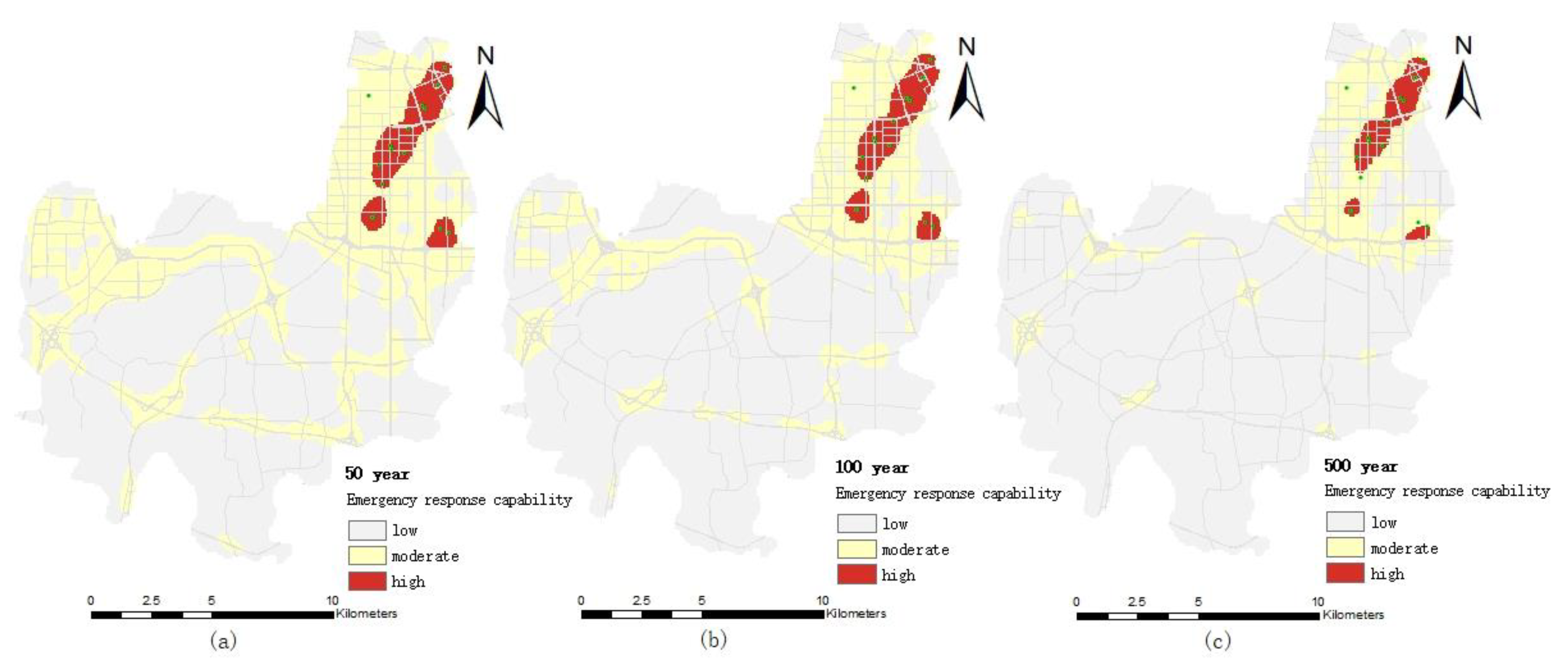
4.2.3. Emergency Response Capability of Public Security Organs
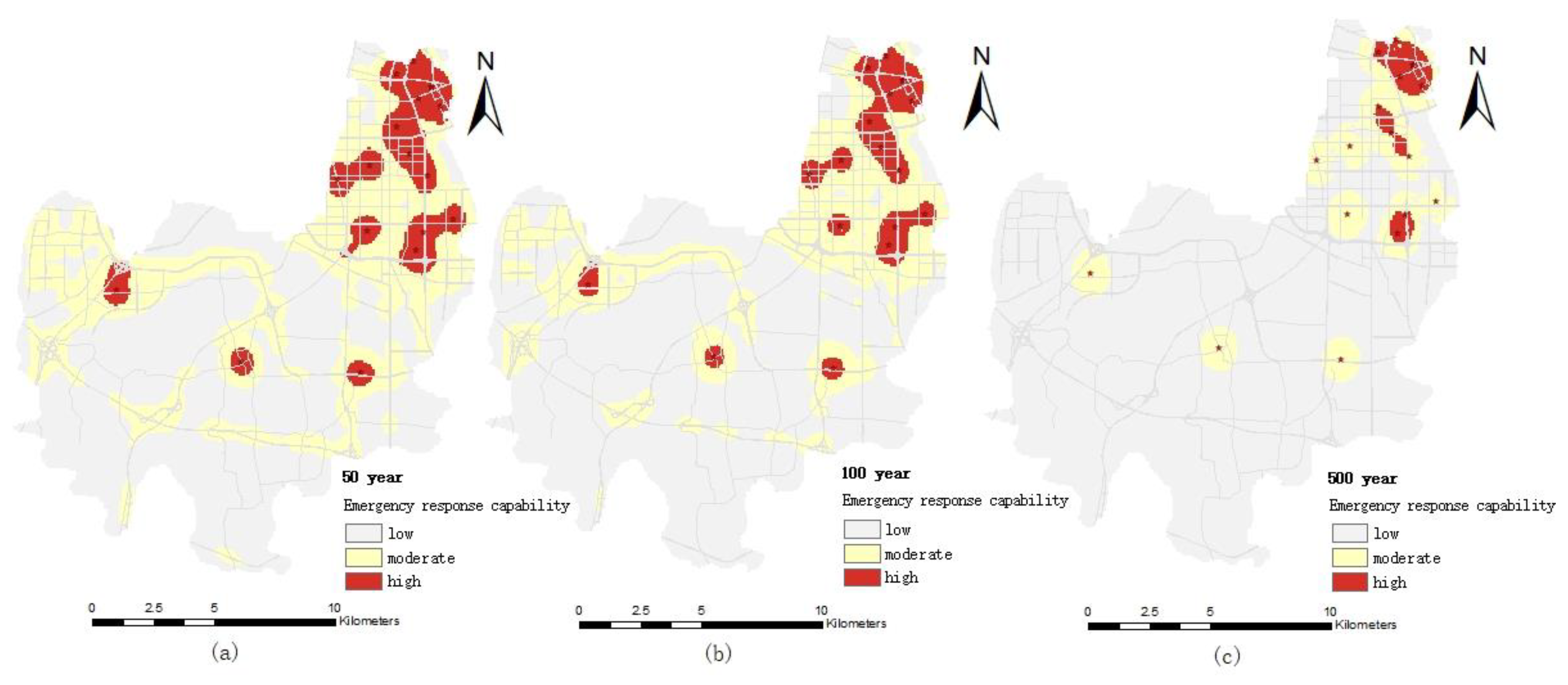
4.2.4. Comprehensive Emergency Response Capability
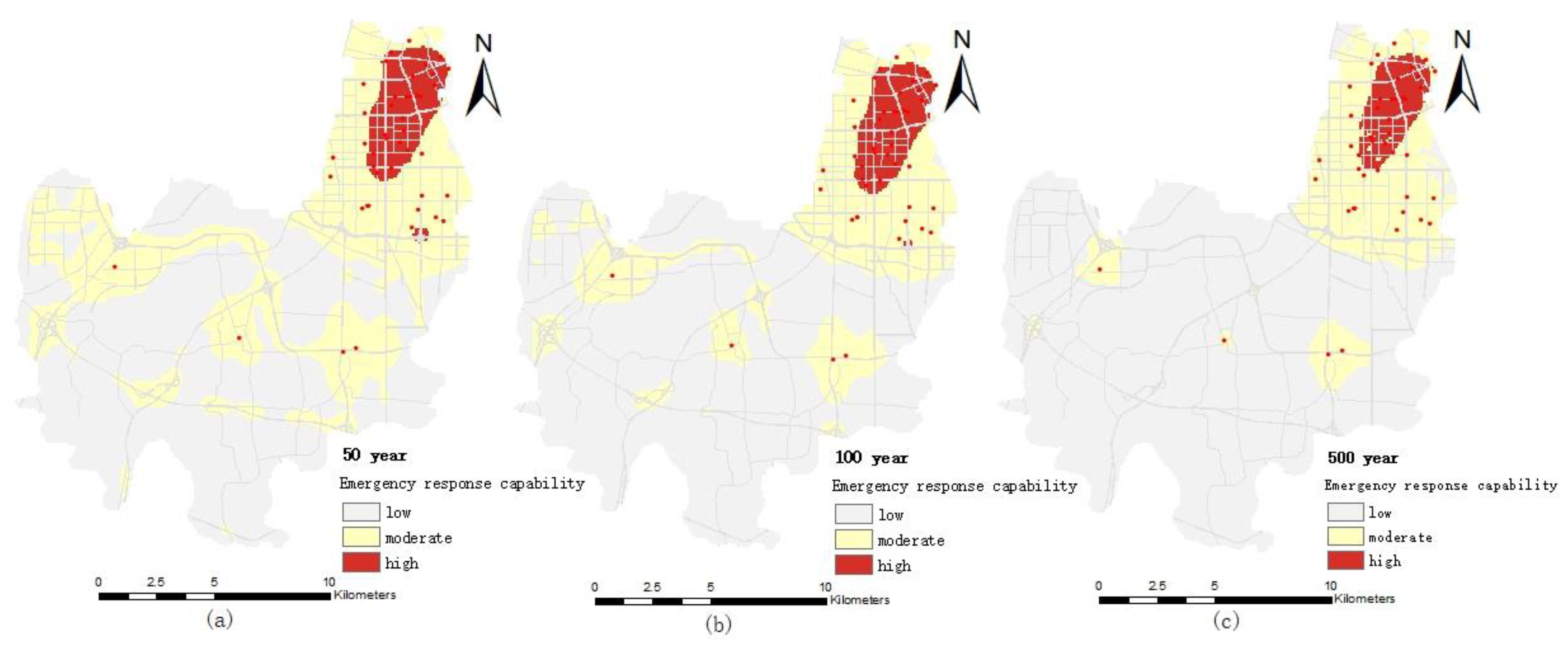
4.2.5. Robustness Test
5. Conclusions and Prospects
5.1. Conclusions
5.2. Prospects
Author Contributions
Funding
Institutional Review Board Statement
Informed Consent Statement
Data Availability Statement
Conflicts of Interest
References
- Yin, J.; Yu, D.; Yin, Z.; Liu, M.; He, Q. Evaluating the impact and risk of pluvial flash flood on intra-urban road network: A case study in the city center of Shanghai, China. J. Hydrol. 2016, 537, 138–145. [Google Scholar] [CrossRef]
- IPCC. Climate Change 2013: Physical Science Base; Cambridge University Press: Cambridge, UK, 2014. [Google Scholar]
- Alabbad, Y.; Mount, J.; Campbell, A.M.; Demir, I. Assessment of transportation system disruption and accessibility to critical amenities during flooding: Iowa case study. Sci. Total Environ. 2021, 793, 148476. [Google Scholar] [CrossRef] [PubMed]
- Zhang, Y.L.; Chen, L. Emergency materials reserve of government for natural disasters. Nat. Hazards 2015, 81, 41–54. [Google Scholar] [CrossRef]
- Zhong, Y. Retraction Note: A flood disaster relief emergency material distribution strategy based on people’s psychological perception. Arab. J. Geosci. 2021, 14, 2770. [Google Scholar] [CrossRef]
- Chen, F.; Chen, J.; Liu, J. Forecast of flood disaster emergency material demand based on IACO-BP algorithm. Neural Comput. Appl. 2021, 34, 3537–3549. [Google Scholar] [CrossRef]
- Simonovic, S.P.; Ahmad, S. Computer-based model for flood evacuation emergency planning. Nat. Hazards 2005, 34, 25–51. [Google Scholar] [CrossRef]
- Chen, F.; Chen, J.; Liu, J. Influencing factors for emergency evacuation capability of rural households to flood hazards in western mountainous regions of Henan province, China. Int. J. Disaster Risk Reduct. 2017, 21, 187–195. [Google Scholar]
- Lin, L.; Wu, Z.; Liang, Q. Urban flood susceptibility analysis using a GIS-based multi-criteria analysis framework. Nat. Hazards 2019, 97, 455–475. [Google Scholar] [CrossRef]
- Song, J.; Chang, Z.; Li, W.; Feng, Z.; Wu, J.; Cao, Q.; Liu, J. Resilience-vulnerability balance to urban flooding: A case study in a densely populated coastal city in China. Cities 2019, 95, 102381. [Google Scholar] [CrossRef]
- Duy, P.N.; Chapman, L.; Tight, M. Resilient transport systems to reduce urban vulnerability to floods in emerging-coastal cities: A case study of Ho Chi Minh City, Vietnam. Travel Behav. Soc. 2019, 15, 28–43. [Google Scholar] [CrossRef]
- Shi, Y.; Yao, Q.; Wen, J.; Xi, J.; Li, H.; Wang, Q. A spatial accessibility assessment of urban tourist attractions emergency response in Shanghai. Int. J. Disaster Risk Reduct. 2022, 74, 102919. [Google Scholar] [CrossRef]
- Coles, D.; Yu, D.; Wilby, R.L.; Green, D.; Herring, Z. Beyond ‘flood hotspots’: Modelling emergency service accessibility during flooding in York, UK. J. Hydrol. 2017, 546, 419–436. [Google Scholar] [CrossRef]
- Green, D.; Yu, D.; Pattison, I.; Wilby, R.; Bosher, L.; Patel, R.; Thompson, P.; Trowell, K.; Draycon, J.; Halse, M.; et al. City-scale accessibility of emergency responders operating during flood events. Nat. Hazards Earth Syst. Sci. 2017, 17, 1–16. [Google Scholar] [CrossRef]
- Yin, J.; Yu, D.; Lin, N.; Wilby, R.L. Evaluating the cascading impacts of sea level rise and coastal flooding on emergency response spatial accessibility in Lower Manhattan, New York City. J. Hydrol. 2017, 555, 648–658. [Google Scholar] [CrossRef]
- Li, X.; Li, M.; Cui, K.; Lu, T.; Xie, Y.; Liu, D. Evaluation of Comprehensive Emergency Capacity to Urban Flood Disaster: An Example from Zhengzhou City in Henan Province, China. Sustainability 2022, 14, 13710. [Google Scholar] [CrossRef]
- Wang, H.; Ye, H.; Liu, L.; Li, J. Evaluation and Obstacle Analysis of Emergency Response Capability in China. Int. J. Environ. Res. Public Health 2022, 19, 10200. [Google Scholar] [CrossRef]
- Fan, F.; Deng, Y.; Hu, X.; Weng, Q. Estimating Composite Curve Number Using an Improved SCS-CN Method with Remotely Sensed Variables in Guangzhou, China. Remote Sens. 2013, 5, 1425–1438. [Google Scholar] [CrossRef]
- Lai, Y.; Lu, Y.; Ding, T.; Sun, H.; Li, X.; Ge, X. Effects of Low-Impact Development Facilities (Water Systems of the Park) on Stormwater Runoff in Shallow Mountainous Areas Based on Dual-Model (SWMM and MIKE21) Simulations. Int. J. Environ. Res. Public Health 2022, 19, 14349. [Google Scholar] [CrossRef]
- Yin, J.; Jing, Y.; Yu, D.; Ye, M.; Yang, Y.; Liao, B. A Vulnerability Assessment of Urban Emergency in Schools of Shanghai. Sustainability 2019, 11, 349. [Google Scholar] [CrossRef]
- Cai, X.; Xu, D. Simulation and Optimization Strategy of Storm Flood Safety Pattern Based on SCS-CN Model. Int. J. Environ. Res. Public Health 2022, 19, 698. [Google Scholar] [CrossRef]
- Bahrami, E.; Salarijazi, M.; Mohammadrezapour, O.; Jou, P.H. Evaluation of SCS model for flood characteristic prediction in an ungauged catchment considering effects of excess rainfall and base flow separation. J. Earth Syst. Sci. 2021, 131, 11. [Google Scholar] [CrossRef]
- Al-Juaidi, A.E.M. A simplified GIS-based SCS-CN method for the assessment of land-use change on runoff. Arab. J. Geosci. 2018, 11, 269. [Google Scholar] [CrossRef]
- Dinka, M.O.; Klik, A. Temporal and spatial dynamics of surface run-off from Lake Basaka catchment (Ethiopia) using SCS-CN model coupled with remote sensing and GIS. Lakes Reserv. Sci. Policy Manag. Sustain. Use 2020, 25, 167–182. [Google Scholar] [CrossRef]
- Mishra, S.; Tyagi, J.; Singh, V.; Singh, R. SCS-CN-based modeling of sediment yield. J. Hydrol. 2006, 324, 301–322. [Google Scholar] [CrossRef]
- Al-Ghobari, H.; Dewidar, A.; Alataway, A. Estimation of Surface Water Runoff for a Semi-Arid Area Using RS and GIS-Based SCS-CN Method. Water 2020, 12, 1924. [Google Scholar] [CrossRef]
- Yu, D.; Yin, J.; Wilby, R.L.; Lane, S.N.; Aerts, J.C.J.H.; Lin, N.; Liu, M.; Yuan, H.; Chen, J.; Prudhomme, C.; et al. Disruption of emergency response to vulnerable populations during floods. Nat. Sustain. 2020, 3, 728–736. [Google Scholar] [CrossRef]
- Ajmal, M.; Moon, G.-W.; Ahn, J.-H.; Kim, T.-W. Investigation of SCS-CN and its inspired modified models for runoff estimation in South Korean watersheds. J. Hydro-Environ. Res. 2015, 9, 592–603. [Google Scholar] [CrossRef]
- Chen, P.; Zhang, J.; Sun, Y. Research on Emergency Rescue of Urban Flood Disaster Based on Wargame Simulation. J. Indian Soc. Remote Sens. 2018, 46, 1677–1687. [Google Scholar] [CrossRef]
- Yin, J.; Yu, D.; Wilby, R. Modelling the impact of land subsidence on urban pluvial flooding: A case study of downtown Shanghai, China. Sci. Total Environ. 2016, 544, 744–753. [Google Scholar] [CrossRef]
- Li, W.; Xu, B.; Wen, J. Scenario-based community flood risk assessment: A case study of Taining county town, Fujian province, China. Nat. Hazards 2016, 82, 193–208. [Google Scholar] [CrossRef]
- Xu, H.; Ma, C.; Lian, J.; Xu, K.; Chaima, E. Urban flooding risk assessment based on an integrated k-means cluster algorithm and improved entropy weight method in the region of Haikou, China. J. Hydrol. 2018, 563, 975–986. [Google Scholar] [CrossRef]
- Zhang, J.-H.; Xu, H.-S.; Wang, T.-Y.; Qi, W.-C. Improved Entropy Weight-TOPSIS-Grey Correlation Method-Based Urban Flood-Waterlogging Risk Assessment. Water Resources and Hydropower Engineering. Available online: https://kns.cnki.net/kcms/detail/10.1746.TV.20220707.1528.002.html (accessed on 8 July 2022).
- Wu, J.J.; Huang, Y.L.; Xie, Z.W.; Wu, X.M. Robust Optimal Design of Deep-notch Elliptical Flexure Hinge Based on Grey Correlation Degree. Modul. Mach. Tool Autom. Manuf. Tech. 2016, 7, 11–14. [Google Scholar]
- Zhong, X.F.; Liu, S.F. Grey relation grade for the analysis of robust designs with dynamic characteristics. Syst. Eng.-Theory Pract. 2009, 29, 147–152. [Google Scholar]

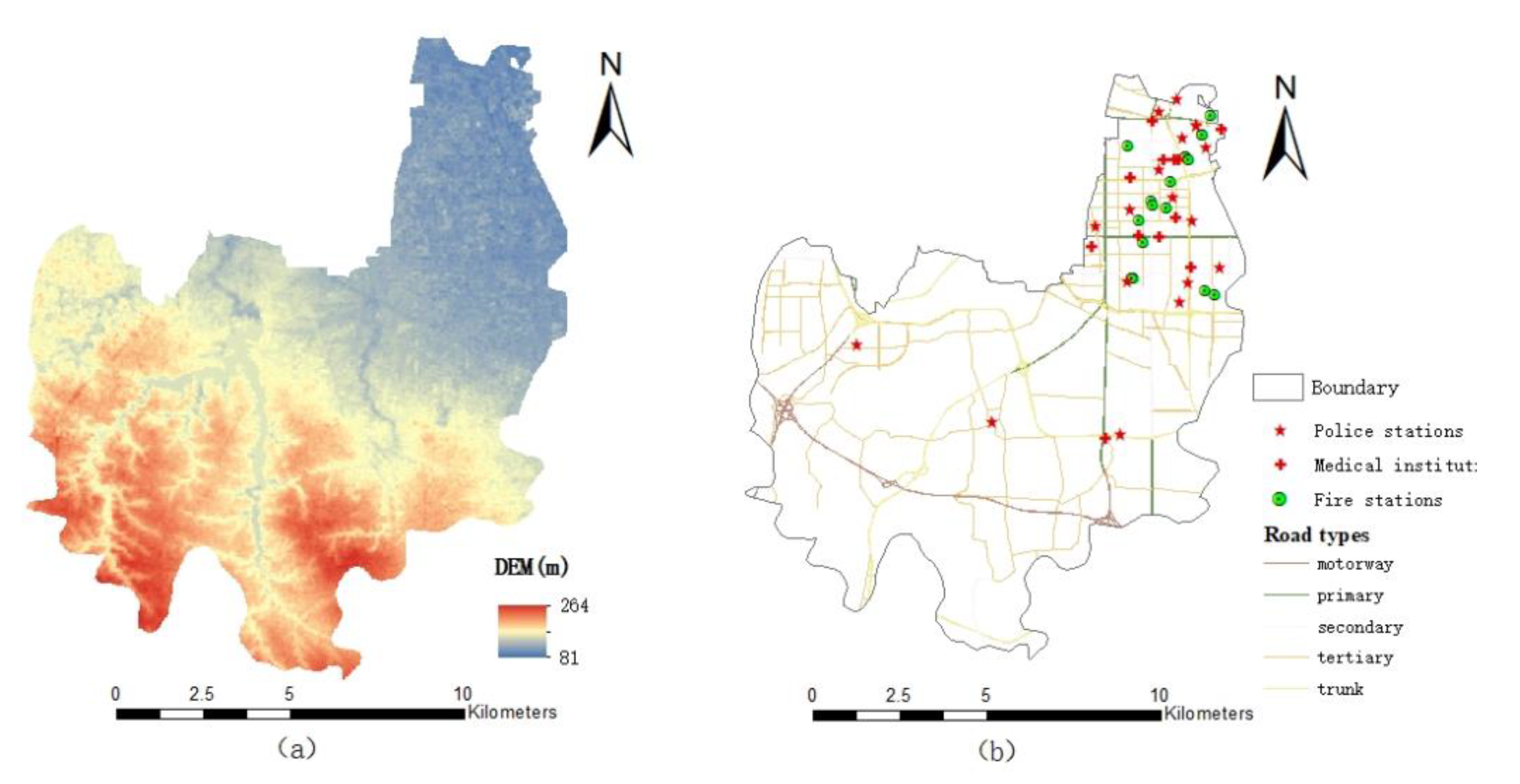
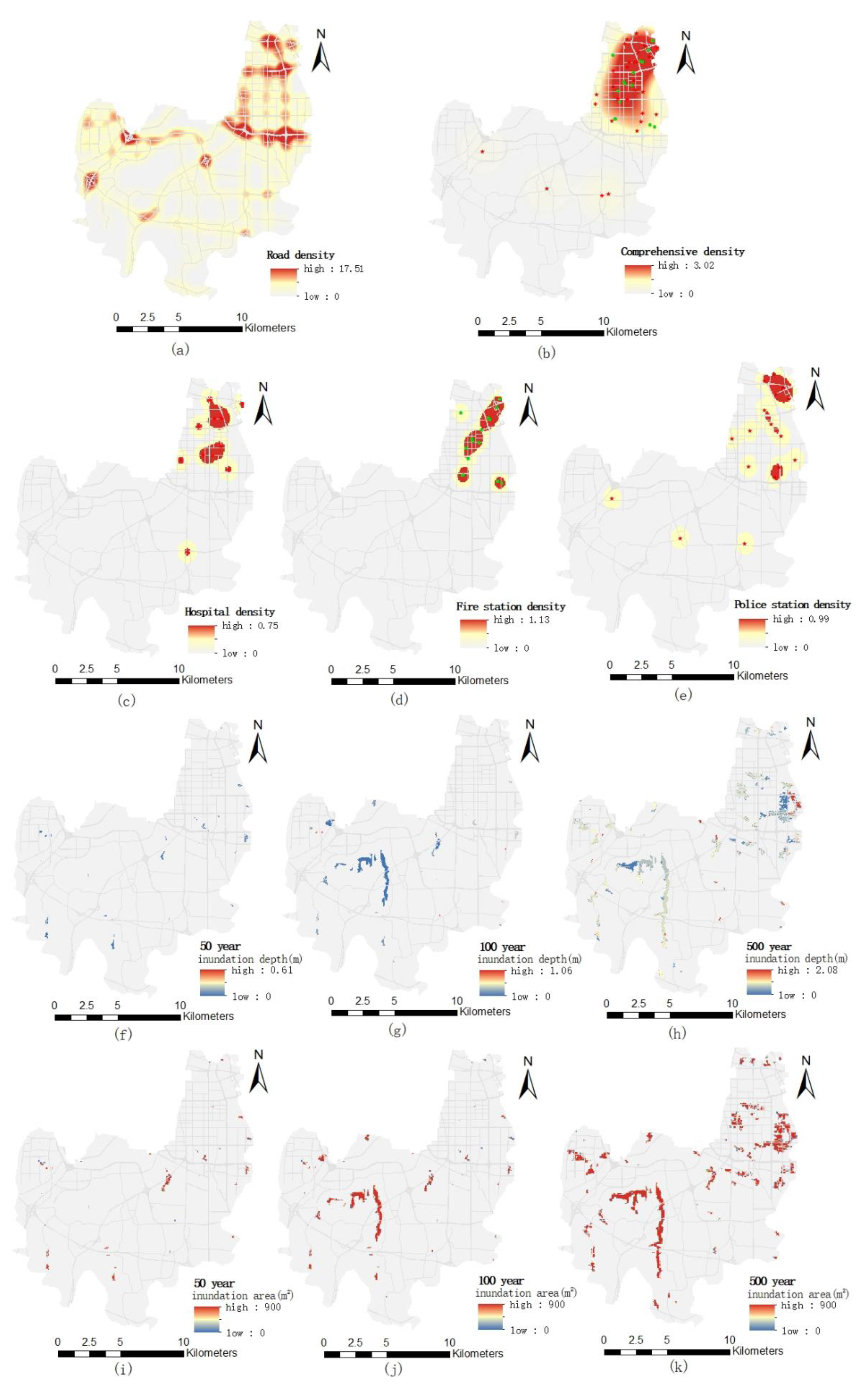
| Land-Use Type | CN Value | Area/km2 | Area Ratio |
|---|---|---|---|
| Forestland | 70 | 52.17 | 0.334 |
| Grassland | 79 | 29.11 | 0.186 |
| Water | 98 | 2.952 | 0.019 |
| Urban land | 90 | 55.25 | 0.353 |
| Roads | 94 | 16.89 | 0.108 |
| Evaluation Item | Correlation Degree | Rank |
|---|---|---|
| Road density | 0.949 | 1 |
| Comprehensive density | 0.858 | 4 |
| Inundation area | 0.859 | 3 |
| Inundation depth | 0.947 | 2 |
| Evaluation Item | Correlation Degree | Rank |
|---|---|---|
| Road density | 0.967 | 1 |
| Comprehensive density | 0.884 | 4 |
| Inundation area | 0.885 | 3 |
| Inundation depth | 0.944 | 2 |
Publisher’s Note: MDPI stays neutral with regard to jurisdictional claims in published maps and institutional affiliations. |
© 2022 by the authors. Licensee MDPI, Basel, Switzerland. This article is an open access article distributed under the terms and conditions of the Creative Commons Attribution (CC BY) license (https://creativecommons.org/licenses/by/4.0/).
Share and Cite
Zhang, Y.; Zhou, M.; Kong, N.; Li, X.; Zhou, X. Evaluation of Emergency Response Capacity of Urban Pluvial Flooding Public Service Based on Scenario Simulation. Int. J. Environ. Res. Public Health 2022, 19, 16542. https://doi.org/10.3390/ijerph192416542
Zhang Y, Zhou M, Kong N, Li X, Zhou X. Evaluation of Emergency Response Capacity of Urban Pluvial Flooding Public Service Based on Scenario Simulation. International Journal of Environmental Research and Public Health. 2022; 19(24):16542. https://doi.org/10.3390/ijerph192416542
Chicago/Turabian StyleZhang, Yongling, Miao Zhou, Nana Kong, Xin Li, and Xiaobing Zhou. 2022. "Evaluation of Emergency Response Capacity of Urban Pluvial Flooding Public Service Based on Scenario Simulation" International Journal of Environmental Research and Public Health 19, no. 24: 16542. https://doi.org/10.3390/ijerph192416542
APA StyleZhang, Y., Zhou, M., Kong, N., Li, X., & Zhou, X. (2022). Evaluation of Emergency Response Capacity of Urban Pluvial Flooding Public Service Based on Scenario Simulation. International Journal of Environmental Research and Public Health, 19(24), 16542. https://doi.org/10.3390/ijerph192416542





